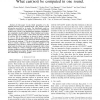Free Online Productivity Tools
i2Speak
i2Symbol
i2OCR
iTex2Img
iWeb2Print
iWeb2Shot
i2Type
iPdf2Split
iPdf2Merge
i2Bopomofo
i2Arabic
i2Style
i2Image
i2PDF
iLatex2Rtf
Sci2ools
62
Voted
CORR
2010
Springer
2010
Springer
Adding a referee to an interconnection network: What can(not) be computed in one round
Abstract—In this paper we ask which properties of a distributed network can be computed from a few amount of local information provided by its nodes. The distributed model we consider is a restriction of the classical CONGEST (distributed) model and it is close to the simultaneous messages (communication complexity) model defined by Babai, Kimmel and Lokam. More precisely, each of these n nodes -which only knows its own ID and the IDs of its neighbors- is allowed to send a message of O(log n) bits to some central entity, called the referee. Is it possible for the referee to decide some basic structural properties of the network topology G? We show that simple questions like, ”does G contain a square?”, ”does G contain a triangle?” or ”Is the diameter of G at most 3?” cannot be solved in general. On the other hand, the referee can decode the messages in order to have full knowledge of G when G belongs to many graph classes such as planar graphs, bounded treewidth graphs a...
| Added | 24 Jan 2011 |
| Updated | 24 Jan 2011 |
| Type | Journal |
| Year | 2010 |
| Where | CORR |
| Authors | Florent Becker, Martín Matamala, Nicolas Nisse, Ivan Rapaport, Karol Suchan, Ioan Todinca |
Comments (0)

